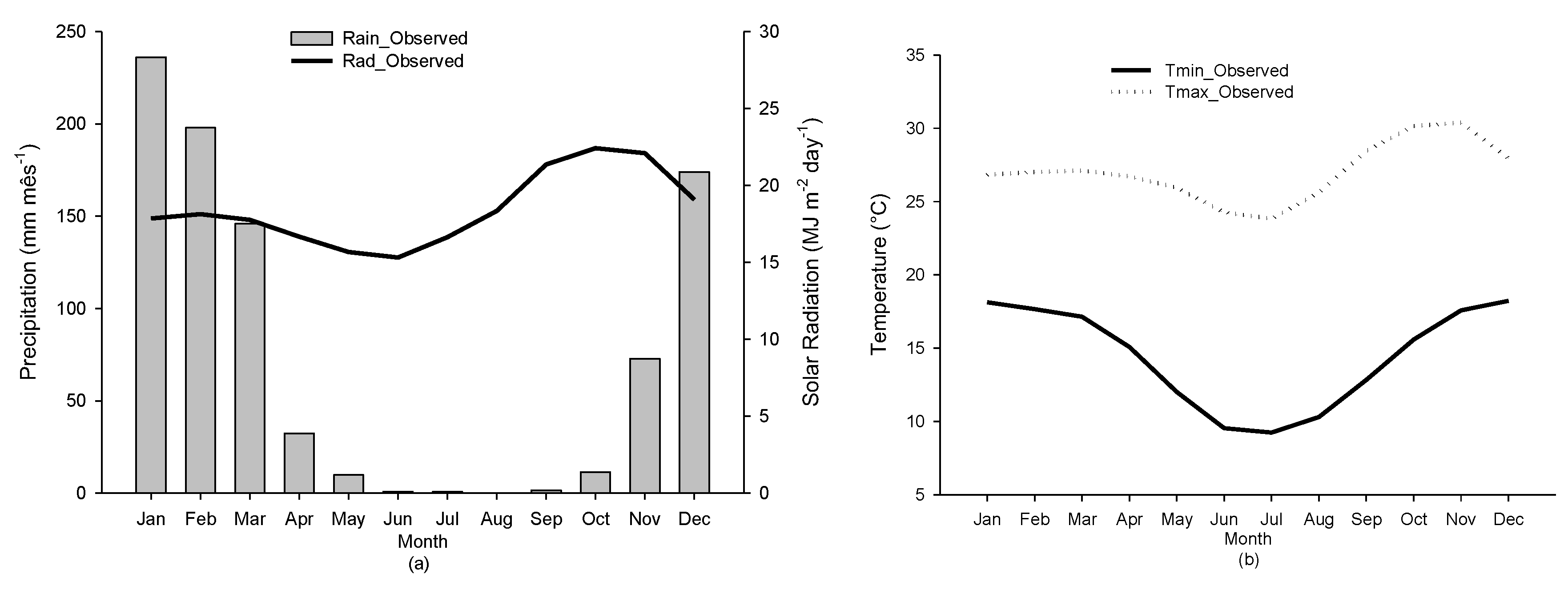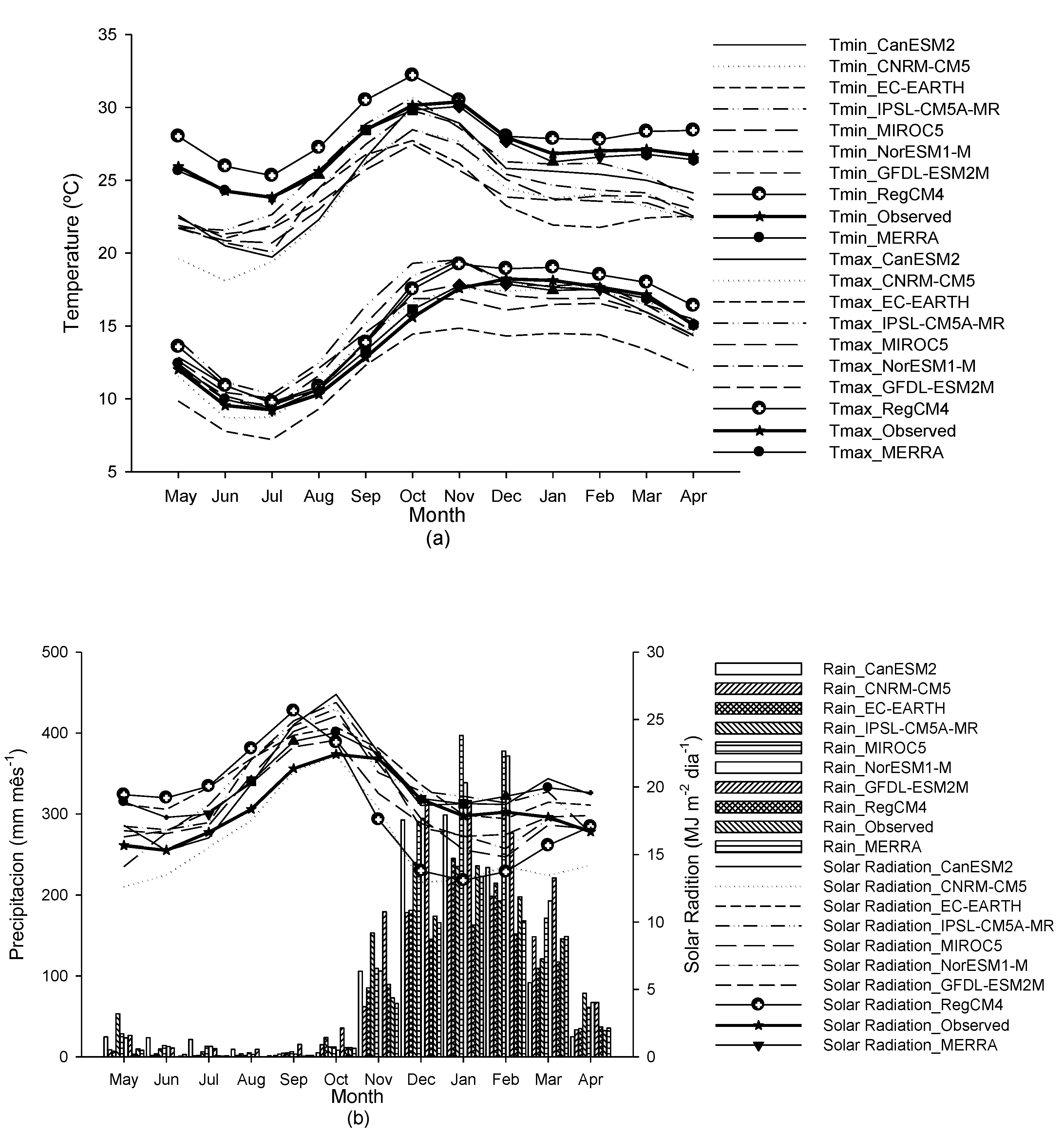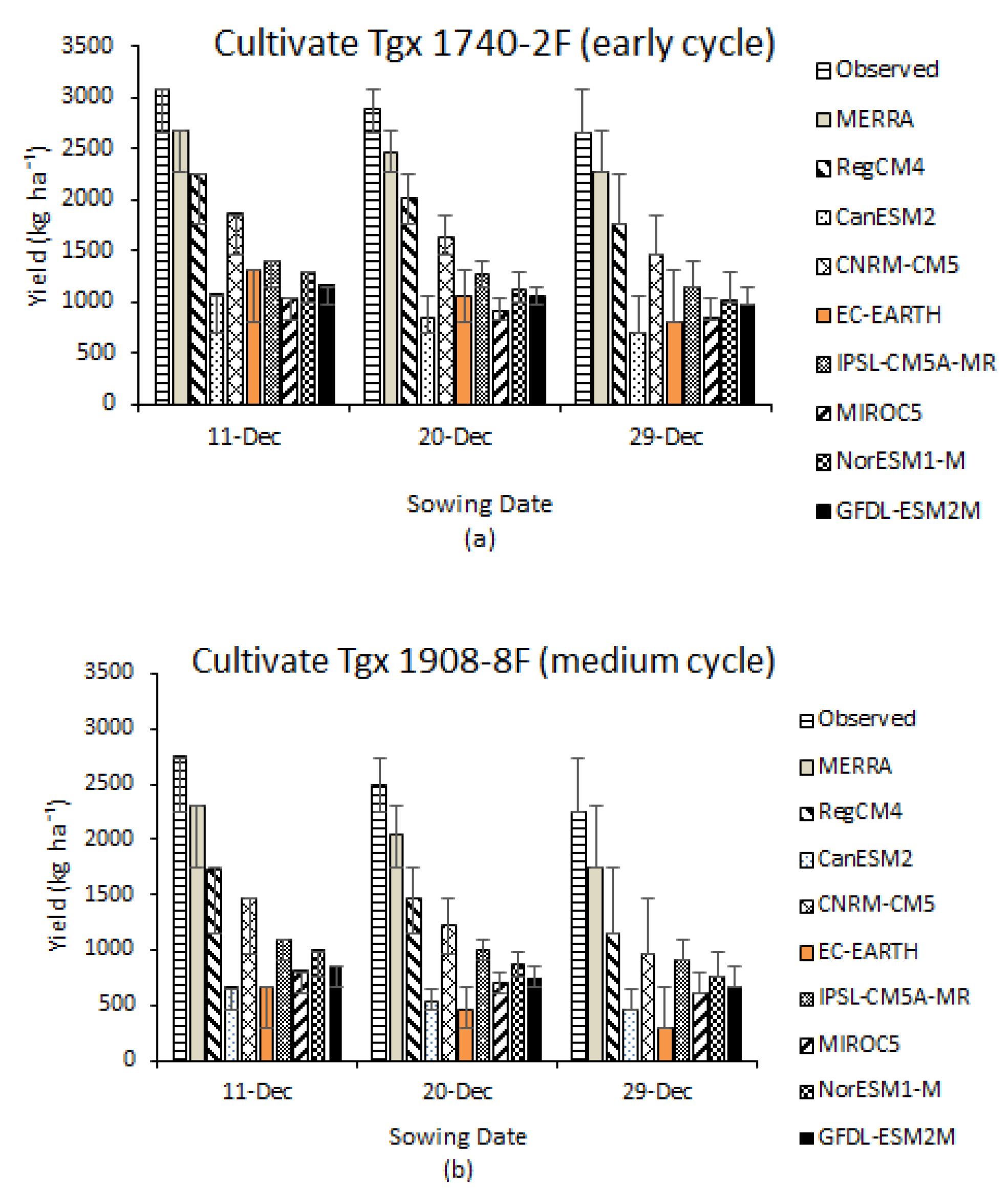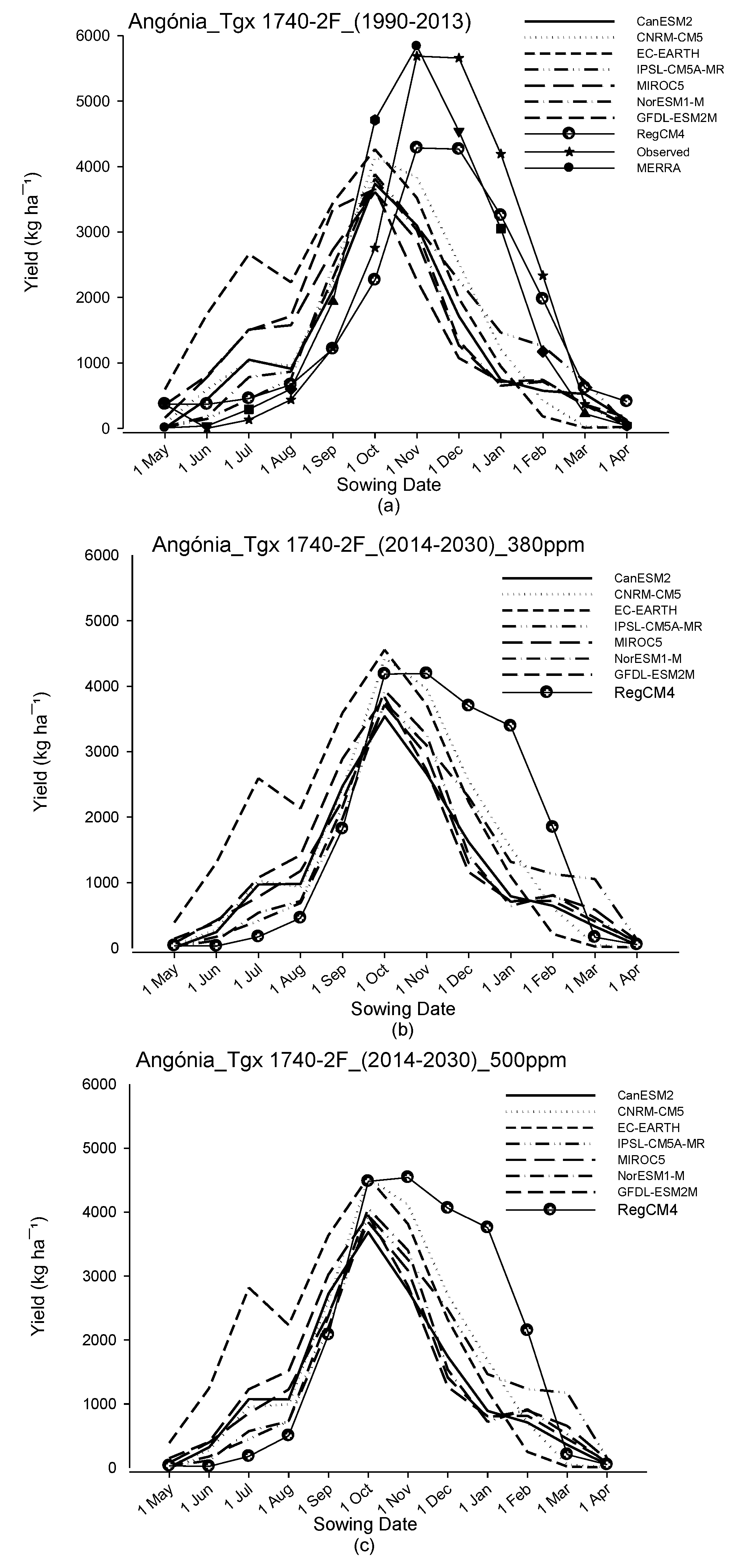3.1. Calibration and Evaluation of CROPGRO-Soybean Model
The genetic coefficients of both cultivars based on the field work, soil, and climate conditions of Angónia obtained from the experimental data in the 2009/2010 and 2010/2011 seasons (
Table 3). The CROPGRO-Soybean model [
10,
11] has been tested and used for a wide variety of soybean cultivars and environmental conditions in previous studies, which demonstrated the ability of this model to capture the variability of important physiological processes [
35,
36,
37,
38]. Nevertheless, the lack of accurate experimental data may result in discrepancies between the model and observations.
Table 4 shows the statistics of the CROPGRO-Soybean results and the field experimental data. The agreement indices (d) were 0.96 (TGx 1740-2F) and 0.99 (Tgx 1908-8F), demonstrating that the model was able to reproduce the observed values.
For the validation of the modeled data, the agreement indices ranged from 0.68 to Tgx 1740-2F and 0.71 for Tgx 1908-8F, with RMSE from 11.48% to 31.13% for Tgx 1740-2F and Tgx 1908-8F, respectively.
Differences between model simulations of 2010/2011 and the field trial are associated with DSSAT modeled genetic coefficients obtained during the 2009/2010 calibration. In some modeling experiments, the factors that can substantially affect performance are accounted for accurately. However, in other field trials, not all parameters needed for a better model simulation are available, hampering a good performance. Indeed, few parameters have been measured during the 2010/2011 field experiments as compared to the 2009/2010 season, leading to limitation for simulating the dry spells response during the grain filing period in 2010/2011, in particular for Tgx 1908-8F cultivar (
Table 4).
Table 5 shows that simulated and observed number of days from emergence to flowering were similar for both soybean cultivars. The estimated occurrence date of different phenological stages is a very important parameter for planning agricultural activities, while the adjusted genetic factors are essential in simulating the growth and development of soybean, and to compare of observed and simulated yield.
In the following work, an evaluation is presented based on additional datasets, namely MERRA reanalysis, CORDEX-Africa, and climate data observations to assess the reliability of these datasets to simulate the current local climate, as well as the related crop yield.
Figure 2 shows that the highest temperature value (30 °C) occurs in October/November, (
Figure 2a). The coldest months are June and July, with average temperatures of 9.5 °C and 9.2 °C, respectively.
Figure 2b shows the distribution of monthly precipitation in the 1980–2010 period. During the dry season, the rainfall was close to zero, while the highest value of 236 mm was recorded in January. This clearly demonstrates a strong seasonal dynamic that is characteristic of subtropical latitudes.
This region has a wide variation in annual rainfall of 725 mm to 1149 mm, with 90% occurring from late November to early April. The highest average values of solar radiation occurred in October and the lowest were observed in May. The MERRA and RegCM4 exhibited the smallest differences as compared to observations. The CORDEX simulations are also in agreement with observations considering the seasonal cycle and values of temperature, precipitation and radiation. Thus, they can be used to simulate initial conditions for driving the DSSAT model to evaluate the climate-crop yield relation.
The lowest average yield occurred for the 29 December sowing date (
Figure 3a,b). Increased precipitation is associated with cloudier atmosphere and subsequently weaker direct incoming solar radiation that provides the most energy absorbed by the plants. Results from MERRA reanalysis, our own observations, and based CORDEX- Africa simulations (
Figure 3a,b), show a sharp drop in yield due to a reduction in solar radiation. It was also noted that, over the sowing dates, the use of DSSAT forced with a MERRA dataset demonstrated reasonable estimates of yield. For all datasets, Tgx 1740-2F (early maturity crop) delivers higher values of yield in relation to medium maturity cultivar Tgx 1908-8F (
Figure 3a,b).
Based on the results from
Figure 2a,b, the best sowing conditions occurred after 1 November due the favorable climatic conditions,
i.e., the beginning of the rainy season and the occurrence of temperature and regimes favorable to crop germination, growth and development, consequently, to achieve elevated yield (
Figure 4) with minor risk of failure by sowing in October due to the variability of rainfall observed in this month. The simulated yields for Tgx 1740-2F and Tgx 1908-8F cultivars are shown in
Table 6.
Our results show that the RegCM4 and CNRM-CM5 models provided more accurate estimates of yield, while other models underestimate yield when compared to observations (
Table 7). All models and MERRA underestimated the observed yield. It should be noted that the yield based on CORDEX results is not directly related to an individual forcing such as monthly changes in radiation or temperature. RegCM4 shows lower values of radiation but displays very reasonable simulated yield. We hypothesize that the modeled soybean response to simulated climate scenarios is closely related to the capability of the climate model to reproduce the daily variability of meteorological parameters, as opposed to representing accurately the monthly climatology.
3.2. Impact of Climate Change on Soybean Yields
In this section, we evaluated the potential influence of climate change on the yield of the cultivars TGX 1740-2F and TGX 1908-8F in Angónia. These simulations have been performed under two CO2 concentrations, 380 ppm and 500 ppm CO2 (2014–2030), under 12 different sowing dates for both cultivars.
For all simulations (
Figure 4), the highest yield in descending order was predicted by RegCM4, CNRM-CM5, CanESM2, IPSL-CM5A-MR, MIROC5, NorESM1-M, GFDL-ESM2M and EC-EARTH. Some models may allow earlier sowing in May such as CNRM-CM5, CanESM2 and IPSL-CM5A-MR. For present day conditions, the RegCM4 and MERRA simulated higher yield between October–December, and lower values are predicted by other CORDEX model results (
Figure 4a). Drastic changes for both cultivars were not simulated when future climate conditions are implemented for both 380 and 500 ppm of CO
2 concentration (
Figure 4b,c). For brevity, we only show the cultivar Tgx 1740_2F. In fact, this may indicate that the increase in CO
2 by 120 ppm under distinct climate forcing such as the RCP 4.5 does not result in non-linearities able to compromise the soybean productivity. Instead, it may induce increased yield as shown by [
12] overcoming the weather factor.
Considering the sowing date (October–January) for the future period (
Figure 4b,c and
Table 8), the models indicated an increase in soybean productivity that is dependent on the CO
2 concentration. This has also been found by [
39]. The CanESM2 shows, however, a reduction of 5% if the predicted future CO
2 concentration (500 ppm) is not taken into account. The highest productivity is predicted by RegCM4, CNRM-CM5 and CanESM2. In general, by comparing both cultivars, we concluded that the Tgx 1908-8F is more sensitive to climate and CO
2 concentration changes showing higher increase in soybean yield. It is also interesting to note the high fluctuation among the models. Similar results for yield increase were found by [
40,
41].










